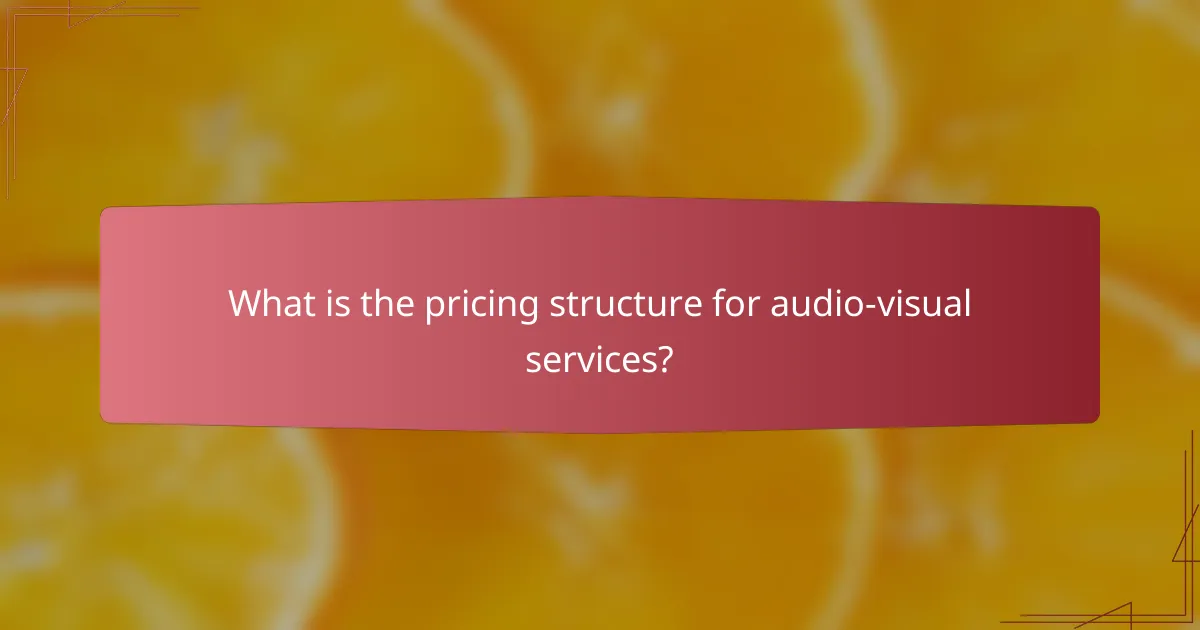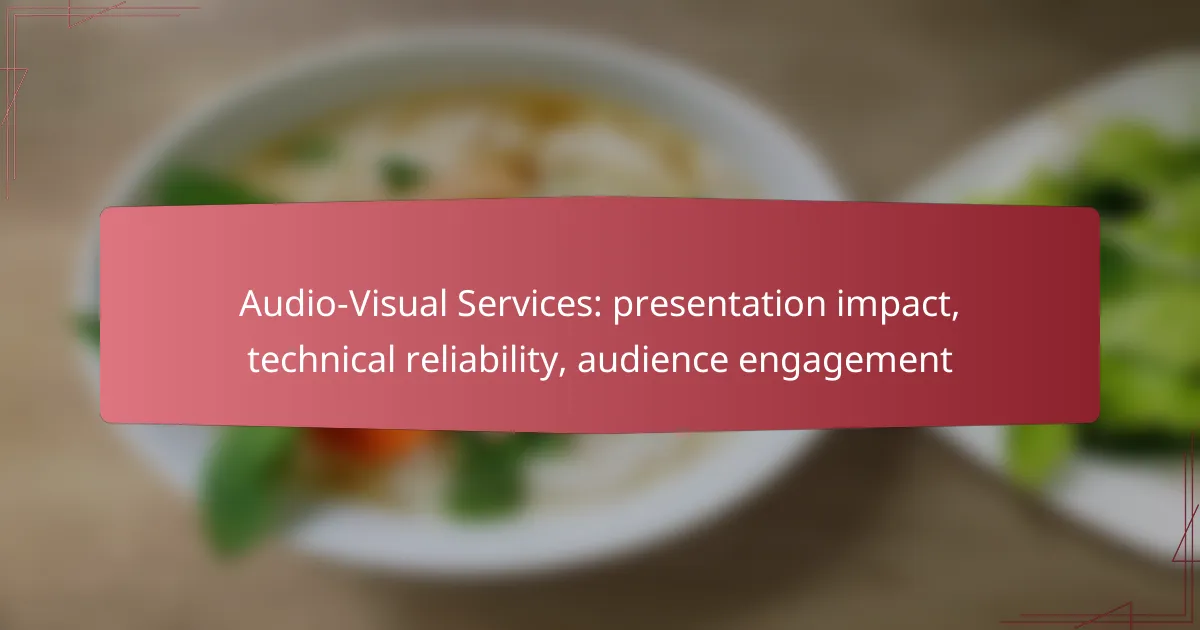Audio-visual services play a crucial role in enhancing presentations by improving clarity, sound quality, and audience engagement. By ensuring technical reliability through well-maintained equipment and real-time support, these services minimize disruptions and create a seamless experience. Furthermore, they foster dynamic and interactive environments that encourage audience participation and enhance information retention.

How can audio-visual services enhance presentations in London?
Audio-visual services significantly enhance presentations in London by improving clarity, sound quality, and overall audience engagement. These services ensure that content is delivered effectively, making it easier for attendees to absorb information and stay focused.
Improved visual clarity
Visual clarity is essential for effective presentations, as it helps the audience understand the content being shared. High-definition projectors and large screens can display images and text with sharpness, making details easily visible from various distances. Consider using screens with at least 1080p resolution for optimal clarity.
When planning your presentation, ensure that visuals are not overcrowded. Use bullet points and high-contrast colors to enhance readability. Test the setup in advance to confirm that all visual elements are clear and legible for the entire audience.
Enhanced sound quality
Sound quality plays a crucial role in keeping the audience engaged during presentations. Clear audio ensures that every word is heard, which is vital in larger venues where background noise can be an issue. Invest in quality microphones and sound systems that suit the size of the room.
For best results, consider using lapel or handheld microphones for speakers, as they provide consistent sound levels. Additionally, perform sound checks before the event to adjust levels and eliminate any feedback issues, ensuring a smooth auditory experience.
Professional lighting solutions
Professional lighting can dramatically impact the mood and focus of a presentation. Proper lighting highlights the speaker and visual aids while minimizing distractions from the audience. Use adjustable lighting to create a comfortable atmosphere that encourages engagement.
Incorporate stage lighting to draw attention to key areas, and consider using dimmable lights to adapt to different segments of the presentation. Avoid harsh overhead lighting that can create glare on screens, and always test lighting setups prior to the event to ensure optimal conditions.

What technical reliability features should you consider?
When planning audio-visual services, consider features that ensure technical reliability, such as equipment maintenance, redundancy systems, and real-time support. These elements help minimize disruptions and enhance the overall presentation experience.
Equipment maintenance protocols
Establishing robust equipment maintenance protocols is crucial for ensuring reliability during presentations. Regular inspections, cleaning, and updates can prevent technical failures. Schedule maintenance checks at least quarterly, and keep a log of all service activities to track equipment performance over time.
Consider implementing a checklist for maintenance tasks, including testing audio levels, checking connections, and verifying software updates. This proactive approach can significantly reduce the risk of equipment malfunction during events.
Redundancy systems
Redundancy systems are essential for maintaining technical reliability, as they provide backup solutions in case of equipment failure. This can include having spare projectors, microphones, or audio mixers readily available. Aim for a 1:1 ratio of critical components to ensure seamless transitions if a primary device fails.
Additionally, consider utilizing cloud-based solutions for storing presentation materials. This allows for quick access and retrieval should local systems encounter issues, ensuring that your presentation can continue without significant interruptions.
Real-time technical support
Having real-time technical support on-site during presentations can greatly enhance reliability. This support ensures that any issues can be addressed immediately, minimizing downtime. Employ a dedicated technician who is familiar with the equipment and can troubleshoot problems as they arise.
It’s advisable to conduct a pre-event technical rehearsal with the support team to identify potential issues and familiarize them with the setup. This preparation can lead to a smoother experience for both presenters and the audience, enhancing overall engagement.

How do audio-visual services boost audience engagement?
Audio-visual services enhance audience engagement by creating dynamic and interactive experiences that capture attention and facilitate participation. By integrating technology into presentations, speakers can foster a more immersive environment that encourages audience involvement and retention of information.
Interactive presentation tools
Interactive presentation tools, such as live polls and quizzes, allow presenters to engage their audience in real-time. These tools can be integrated into platforms like PowerPoint or specialized software, enabling participants to respond using their smartphones or tablets.
Using interactive tools can significantly increase audience participation, often leading to higher retention rates. For example, incorporating a quick quiz during a presentation can keep the audience focused and encourage them to think critically about the material being presented.
Audience response systems
Audience response systems, often referred to as clickers or polling systems, enable real-time feedback from attendees. These systems allow participants to answer questions anonymously, which can lead to more honest responses and a better understanding of audience sentiment.
Implementing these systems can be particularly effective in larger venues where direct interaction is challenging. They can help presenters gauge understanding and adjust their delivery on the fly, ensuring that the content resonates with the audience.
Immersive experiences
Immersive experiences, such as virtual reality (VR) or augmented reality (AR), provide a unique way to engage audiences by placing them in interactive environments. These technologies can transform traditional presentations into captivating experiences that allow participants to explore concepts in a hands-on manner.
When considering immersive experiences, it’s essential to ensure that the technology aligns with the presentation goals and audience demographics. For instance, using VR for a training session can enhance learning outcomes, while AR can provide additional context in product demonstrations, making the content more relatable and memorable.

What are the key factors in selecting an audio-visual service provider in the UK?
When selecting an audio-visual service provider in the UK, consider their experience, client feedback, and the areas they serve. These factors significantly influence the quality of your event’s presentation, technical reliability, and audience engagement.
Experience and expertise
Experience and expertise are crucial when choosing an audio-visual service provider. Look for companies that have a proven track record in delivering successful events similar to yours, whether they are corporate meetings, weddings, or large conferences.
Consider the technical skills of their team, including knowledge of the latest AV technology and equipment. A provider with a diverse portfolio can adapt to various event formats and requirements, ensuring a smooth execution.
Client testimonials
Client testimonials provide valuable insights into the reliability and quality of an audio-visual service provider. Seek out reviews and case studies that highlight their strengths and weaknesses, focusing on aspects such as professionalism, responsiveness, and problem-solving abilities.
Positive feedback from previous clients can indicate a provider’s ability to engage audiences effectively and handle technical challenges. Don’t hesitate to ask for references to get firsthand accounts of their service quality.
Service area coverage
The service area coverage of an audio-visual provider is essential, especially if your event is in a specific location. Ensure that the provider operates in your desired area and can deliver equipment and support without significant delays or additional costs.
Some providers may have regional specialties or limitations, so clarify their operational reach. Consider local providers for better logistical support and familiarity with venue requirements, which can enhance the overall event experience.

What is the pricing structure for audio-visual services?
The pricing structure for audio-visual services typically includes hourly rates, package deals, and additional service costs. Understanding these components helps businesses budget effectively for events and presentations.
Hourly rates
Hourly rates for audio-visual services can vary significantly based on location, equipment quality, and technician expertise. Generally, you might expect rates to range from $50 to $150 per hour. It’s essential to clarify what is included in the hourly rate, such as setup time and equipment usage.
When hiring technicians, consider their experience and the complexity of your event. More specialized services may command higher rates, so weigh the benefits against your budget constraints.
Package deals
Package deals often provide a more cost-effective solution for comprehensive audio-visual needs. These packages typically bundle services like sound, lighting, and video projection, offering a flat rate that can save you money compared to booking each service separately. Prices for packages can range from a few hundred to several thousand dollars, depending on the scale of the event.
When evaluating package deals, ensure that they meet your specific requirements. Some providers may offer customizable packages, allowing you to select only the services you need.
Additional service costs
Additional service costs can arise from extra equipment rentals, specialized technical support, or extended hours. For instance, renting high-end projectors or sound systems may incur additional fees, which can add up quickly if not anticipated. Always ask for a detailed breakdown of potential extra charges before finalizing your agreement.
To avoid surprises, consider discussing your event’s specific needs with your audio-visual provider upfront. This proactive approach can help you identify any potential additional costs and incorporate them into your overall budget.

How do permits affect audio-visual installations in public venues?
Permits are crucial for audio-visual installations in public venues as they ensure compliance with local laws and safety regulations. Obtaining the necessary permits can impact the timeline and cost of your project, making it essential to understand the requirements early in the planning process.
Local regulations
Local regulations vary widely and can dictate the types of audio-visual equipment allowed, installation methods, and safety standards. For instance, some municipalities may require specific permits for electrical work or structural modifications. It’s important to check with local authorities to identify any licensing or zoning laws that may apply to your event.
Failure to comply with local regulations can result in fines, project delays, or even the cancellation of your event. Always consult the relevant city or county office to ensure you have the most current information regarding permits and regulations.
Venue-specific requirements
Each venue may have its own set of requirements for audio-visual installations, which can include restrictions on equipment types, installation procedures, and insurance coverage. Some venues may require you to use their in-house AV team or to provide proof of liability insurance before granting access to their facilities.
To avoid complications, review the venue’s policies thoroughly and communicate with their management early in the planning stages. This proactive approach can help you identify any additional costs or logistical challenges associated with your audio-visual setup.



